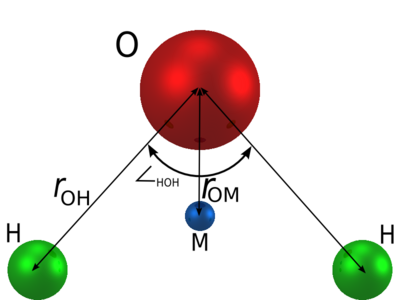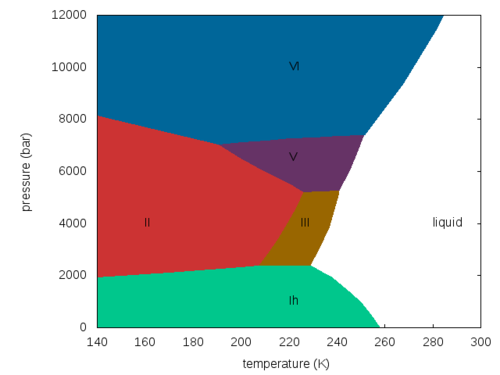TIP4PQ/2005 model of water
Jump to navigation
Jump to search
The TIP4PQ/2005 model [1] is a re-parameterisation of the TIP4P/2005 potential for quantum path integral simulations of water, in particular for the ice phases. The difference between the TIP4P/2005 and the TIP4PQ/2005 models is the dipole moment, which increases from 2.305D to 2.38D thanks to the difference in the charges: TIP4P/2005 q(H) (e) is 0.5564 whereas for the TIP4PQ/2005 model this becomes 0.5764e.
Parameters[edit]

| (Å) | HOH , deg | (Å) | (K) | q(O) (e) | q(H) (e) | q(M) (e) | (Å) |
| 0.9572 | 104.52 | 3.1589 | 93.2 | 0 | 0.5764 | -2q(H) | 0.1546 |
Phase diagram[edit]
The phase diagram of the TIP4PQ/2005 model in the pressure-temperature plane (adapted from Fig. 3 of [2])
Density maximum[edit]
The TIP4PQ/2005 model has a density maximum in the liquid phase at 280K [3].
References[edit]
- ↑ Carl McBride, Carlos Vega, Eva G. Noya, Rafael Ramirez, Luis M. Sese "Quantum contributions in the ice phases: the path to a new empirical model for water -- TIP4PQ/2005", Journal of Chemical Physics 131 024506 (2009)
- ↑ Carl McBride, Eva G. Noya, Juan L. Aragones, Maria M. Conde and Carlos Vega "The phase diagram of water from quantum simulations", Physical Chemistry Chemical Physics 14 pp. 10140-10146 (2012)
- ↑ E. G. Noya, C. Vega, L. M. Sesé, and R. Ramírez "Quantum effects on the maximum in density of water as described by the TIP4PQ/2005 model", Journal of Chemical Physics 131 124518 (2009)
Related reading
- C. Vega, M. M. Conde, C. McBride, J. L. F. Abascal, E. G. Noya, R. Ramirez, and L. M. Sesé "Heat capacity of water: A signature of nuclear quantum effects", Journal of Chemical Physics 132 046101 (2010)
- Briesta S. González, Eva G. Noya, Carlos Vega and Luis M. Sesé "Nuclear Quantum Effects in Water Clusters: The Role of the Molecular Flexibility", Journal of Physical Chemistry B (Article ASAP) (2010)





